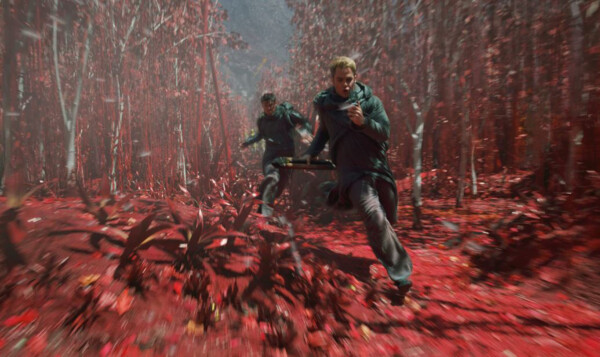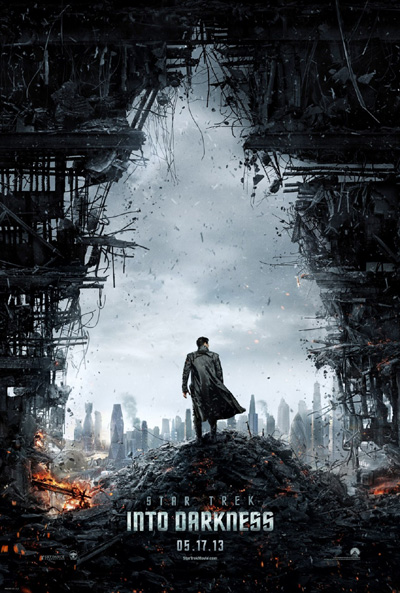Mladen and Del review ‘Star Trek Into Darkness’

Image courtesy of Paramount Studios.
—
“Star Trek Into Darkness” Starring Chris Pine, Benedict Cumberbatch, Zachary Quinto, Zoe Saldana, Peter Weller. Directed by JJ Abrams. 132 minutes. Rated PG.
Mladen’s take
After watching “Star Trek Into Darkness,” I decided to produce and direct my own movie. It’ll be titled: “Mladen Rudman Into Frustration.”
The most recent version of Star Trek left me feeling unsatisfied, as though I had ordered a steak but gotten cotton candy.
A few parts of the film were good; most others stank. The circumstance that allowed Scotty to stay alive to open the door of an air lock that permitted a commando raid on the bigger and badder version of the U.S.S. Enterprise was all stinkiness.
The scene was all the more stinky because it was crucial. Had Scotty not stayed alive, the film would have had no place to go. The End. An implausible scene that keeps a story going wrecks a movie’s authenticity.
And, there’s too much crying in the movie.
Here’s a rule all producers and directors should follow when building a science fiction adventure film.
A man cries only when he’s enduring extreme physical pain. Your large intestine twisted into a half-hitch knot being chewed by a pit bull is an example of extreme pain. Tears are warranted in that case. Everything else – a friend dying from exposure to radiation – is a prompt for murderous revenge without tears intervening.
“Into Darkness” suffers from the Great Malaise of Hollywood, which Del addresses indirectly. He wonders if “Into Darkness” would appeal to everyone but Trekkies, which is precisely the point.
The studio should have stayed focused.
The studio should have made it a movie that would be liked only by Trekkies and guys like me who appreciate a good sci-fi film though mostly unfamiliar with the lore of Star Trek.
Look, all I need to know is that the crew of the Enterprise has been tasked with boldly going where no one has gone before and, when necessary, blowing the hell out of nasty indigenous life forms.
That friendships exist can be established by the way an away team dodges death rays and demolishes starships. Or by the fact that a crew stuck on an interstellar vessel for months at a time hasn’t torn itself apart.
We all know that humans like to couple and endure the emotional ravages of relationships going awry. Who cares about Spock’s and Uhura’s dating woes when you’re at the edge of the Neutral Zone violating the Klingon empire’s sovereignty? If I want a dose of the touchy feelies, I’ll see a “Twilight” movie.
In fact, I resent their squabbling and I’ll tell you why. It happened aboard a shuttle approaching a Klingon planet. The shuttle scene should have been replaced by something “Into Darkness” sorely lacked – open space battles among ships floating in a vacuum. What I wanted to see was a cloaked Klingon warbird suddenly materialize to fire on the Enterprise.
Remember the Romulan starship Narada in the very good 2009 “Star Trek”?
Narada was massive, looked like a multi-bladed serrated knife and fired missiles that fired smart submunitions targeting an enemy’s most sensitive systems. Watching U.S.S. Kelvin wither under its fire, the scenes of obliteration outside the spacecraft were silent, was impressive and accurate.
Abrams tried to make “Into Darkness” a movie that pleases everyone – women, men, teenagers, dogs, sea cucumbers – and will likely end up pleasing almost no one.

Del’s take
What I would say about “Star Trek Into Darkness” is: Yet another movie ruined by writer Damon Lindelof.
How long will it be until studios bar their pitch room doors to this person? If M. Night Shyamalan is any indication, I guess we can expect a long and dismal tradition of “Prometheuses” springing from the keyboard of the overrated Lindelof, who seems to understand nothing about story structure, character interaction and pathos.
It’s a shame, really, because “Into Darkness” could have been a fine summer movie. Instead, it is a collage of spangly images held together by a thin gossamer of story, a web so insubstantial that very little gets caught and the audience leaves hungry.
Its saving grace is a script that allows for a little self-deprecating fun, and command performances by at least three cast members: Chris Pine, Benedict Cumberbatch and Peter Weller. Others praised Zachary Quinto’s turn as Mr. Spock (though he and Leonard Nimoy assemble a much better performance in an Audi commercial) or the ensemble Star Trek “family” members (Saldana, Anton Yelchin and John Cho).
I’ve never thought much of Pine as an actor but I admit, he seems to capture my notion of a younger, friskier James Tiberius Kirk, whose disregard for protocol and willingness to indulge in gut instinct chafes the collective neck of the powers that be.
Peter Weller walks a highwire between bad and good, what I call “reasonable evil” – a person who’s able to convince others of the righteousness of his cause without sounding like a lunatic. For me he evoked a memory of Sterling Hayden in “Doctor Strangelove,” a man who, when you stand back and look at the cold truth of his worldview, is obviously insane, but sounds somewhat reasonable – his words make a kind of sense that doesn’t bear close inspection.
Better, “Into Darkness” isn’t just dominated but overwhelmed by Benedict Cumberbatch, the mysterious trenchcoated figure in the posters and trailers. Had Cumberbatch been given room to move he might have become the most insidious movie villain since Hans Gruber of “Die Hard” infamy. Unfortunately, his screen time is limited, to the movie’s detriment.
The movie ties together some loose threads from “Star Treks” that preceded it, and I won’t discuss them here for fear of spoiling the surprises. Suffice it to say you should brush up on your Trek lore before venturing into the darkness.
Weaknesses? The real plot of “Into Darkness” orbits Weller and Cumberbatch, who are given the short shrift in favor of the unconvincing bromance between Kirk and Spock, the wildly unconvincing romance between Spock and Uhura, and the silly notion Kirk should be allowed to run amok and do as he pleases, disregarding the accumulated wisdom of the human race. It’s a wonder we ever got into space without him.
Special effects are first rate. London and San Francisco get a 23rd century dressing up, and Enterprise interiors look less like a deep space-going craft than a 21st century corporate high-rise – that is until you venture into “Engineering,” which resembles nothing more than a glue factory.
Overall, however, I couldn’t escape the feeling I was watching a fleshed-out TV episode of a show based loosely on the original “Star Trek.” Gone is the wonder of discovery, the “new worlds” and “new civilizations” that made the original series such a unique experience, replaced by an irritating Millennial approach to work and life: To hell with your rules and institutions; I’ll do what I want, when I want.
Trekkies will probably be disappointed, which is OK if you can deliver a product that pleases everybody else. It’s the everybody else I wonder about. Is there enough meat on the bones of “Into Darkness” to please the larger movie-going audience?
At this point I can’t say there is. Its skimpy storyline, which I place squarely on the shoulders of writers like Lindelof, doom it to mediocrity.
As Hollywood struggles to woo fans into theaters and away from Netflix, it does not need a $190 million tentpole that underperforms at the box office. “Into Darkness” may not do as well as the 2009 rendering of “Star Trek,” which would be bad news for hosting studio Paramount and JJ Abrams.
Let’s hope he keeps Lindelhof in a galaxy far, far away from “Star Wars.”
Mladen Rudman is a former journalist and public information officer. Del Stone Jr. is a former journalist and author.